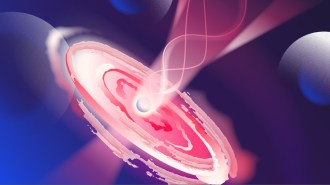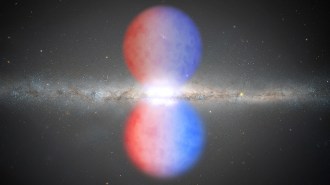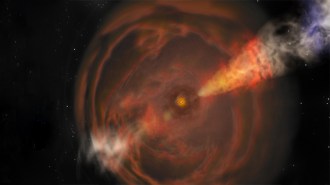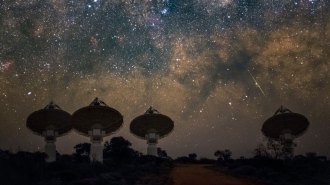Space
Sign up for our newsletter
We summarize the week's scientific breakthroughs every Thursday.
-
 Space
SpaceBlack hole plasma jets are shaped like bell-bottoms
Jets of high-energy particles change from slightly curved sides to flared cones as they shoot away from galaxies, just like flare-legged pants.
-
 Particle Physics
Particle PhysicsMeasuring the neutron’s lifetime from space could solve an enduring mystery
Measurements on Earth show that lone neutrons decay after about 15 minutes, and now scientists have measured that lifetime from space.
-
 Space
SpaceFlat spots on Saturn’s moon Titan may be the floors of ancient lake beds
Bright radio signals from Titan indicate the presence of ancient lake beds in its tropics, a new analysis finds.
-
 Quantum Physics
Quantum PhysicsThis weird quantum state of matter was made in orbit for the first time
Bose-Einstein condensates made on the International Space Station could reach temperatures lower than any known in the universe.
-
 Space
SpaceThe Milky Way’s giant gas bubbles were seen in visible light for the first time
Variation in the light’s wavelengths could help scientists map the velocity of the gas that makes up the towering structures known as Fermi bubbles.
-
 Space
SpaceA Milky Way flash implicates magnetars as a source of fast radio bursts
A bright radio burst seen from a magnetar in the Milky Way suggests that similar objects produce the mysterious fast radio bursts observed in other galaxies.
-
 Space
SpaceA weird cosmic flare called the ‘Cow’ now has company
Scientists have now found three similar luminous, short-lived bursts of light, part of a class known as fast blue optical transients.
-
 Planetary Science
Planetary ScienceMeteorites might be more likely to strike near the equator
Meteorites from Antarctica have helped scientists assess the total number likely to hit Earth every year — and where they are most likely to fall.
By Shannon Hall -
 Space
SpaceSpaceX’s astronaut launch marks a milestone for commercial spaceflight
Two NASA astronauts aboard the privately built Crew Dragon capsule are the first to be sent into orbit from U.S. soil since 2011.
-
 Space
SpaceHalf the universe’s ordinary matter was missing — and may have been found
Astronomers have used fast radio bursts as cosmic weigh stations to tease out where the universe’s “missing matter” resides.
-
 Physics
PhysicsA star shredded by a black hole may have spit out an extremely energetic neutrino
A star’s fatal encounter with a black hole might have produced a neutrino with oomph.
-
 Space
SpaceStunning images of swirling gas and dust may show a planet forming
Infrared images show a spiral of gas and dust around a star 520 light-years away. A smaller, tantalizing twist hints at where a planet is coalescing.